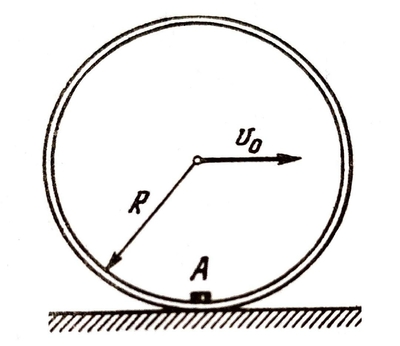Mechanics |15-10-2020|
 A small body
is fixed to the inside of a thin rigid hoop of radius
and mass equal to that of body
. The hoop rolls without slipping over a horizontal plane. At the moment when the body
gets into the lower position, the center of the hoop moves with velocity
.
A small body
is fixed to the inside of a thin rigid hoop of radius
and mass equal to that of body
. The hoop rolls without slipping over a horizontal plane. At the moment when the body
gets into the lower position, the center of the hoop moves with velocity
.
If the hoop moves without bouncing when , find .
This is one of my favorite problem taken from I.E. Irodov.
The answer is 2.828.
This section requires Javascript.
You are seeing this because something didn't load right. We suggest you, (a) try
refreshing the page, (b) enabling javascript if it is disabled on your browser and,
finally, (c)
loading the
non-javascript version of this page
. We're sorry about the hassle.
We note that the hoop is most likely to bound when body A is in the highest position. Let the velocity of the center of the hoop be v when body A is at the top position. Using the center of the hoop as reference, the translational velocity of body A when it is at the bottom is 0 , while that when it is at the top position is 2 v . The moment of inertia of body A is I = m R 2 and its angular velocity ω = R v . By the conversation of energy on the two position, we have:
body A 0 + 2 1 m R 2 ( R v 0 ) 2 − m g R + hoop 2 1 m v 0 2 v 0 2 − g R ⟹ v 2 = body A 2 1 m ( 2 v ) 2 + 2 1 m R 2 ( R v ) 2 + m g R + hoop 2 1 m v 2 = 3 v 2 + g R = 3 v 0 2 − 2 g R
Consider the forces acting on the hoop and A as a combined body, when A is on top, we have 2 m g = m ω 2 R + N = R m v 2 + N , where N is the normal reaction force. For the combined body not to bounce, N ≥ 0 or
2 m g v 2 3 v 0 2 − 2 g R v 0 2 ⟹ v 0 ≥ R m v 2 ≤ 2 g R ≤ 2 g R ≤ 8 g R ≤ 8 g R
Therefore α = 8 ≈ 2 . 8 3 .